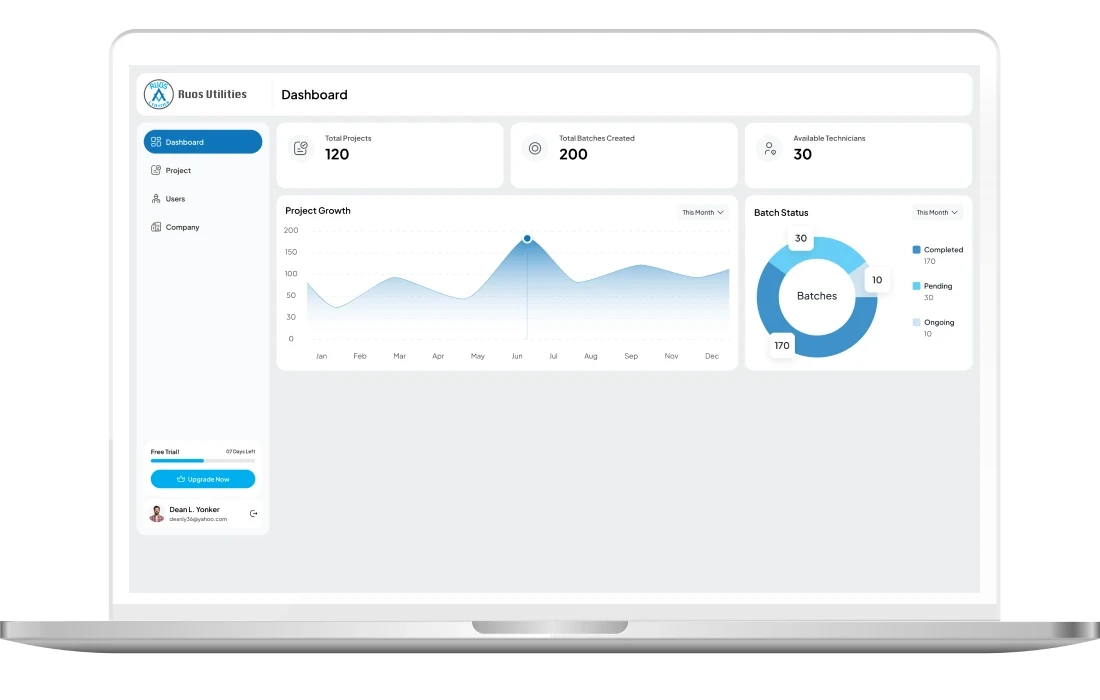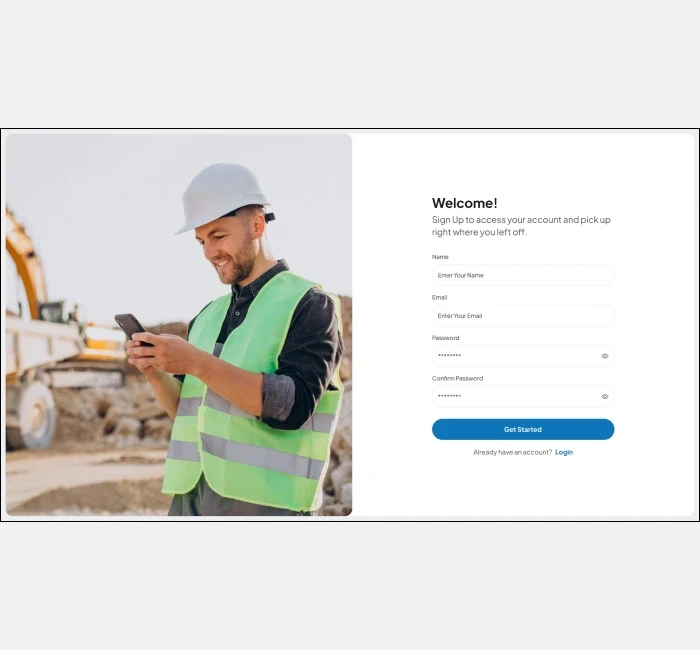About Ruos Utilities
RUOS Utilities is a forward-thinking utilities management company focused on modernizing data collection and field operations.
Before engaging with our team, they were dependent on fragmented and outdated systems like Excel, Esri Field Maps, and BatchGeo. These manual processes caused bottlenecks in project delivery and limited the platform’s scalability to other utility companies.
With plans to scale and introduce a white-labeled solution to the broader market, RUOS set out to transform its workflows into a centralized, efficient, and modern software product—ultimately launching the RUOS Utilities platform.


The Challenge
RUOS faced several operational and technical hurdles:
- Manual processes using Excel and BatchGeo resulted in delays of up to 2 hours for mapping each project.
- Inefficient field data collection workflows led to poor technician productivity.
- Data syncing and reporting were often delayed or prone to errors.
- No centralized system for client management or subscription billing.
- The platform lacked the flexibility to scale across multiple utility companies.
Our Strategy
Our team approached this project systematically, breaking it down into distinct phases:
Phase 1
Discovery
We began by understanding RUOS’s existing process map and identifying the pain points in their data collection, project management, and reporting workflows. The goal was to build an integrated mobile and web solution tailored for both field technicians and admin users.
Phase 2
Planning
A high-level architecture was created, outlining the project flows:
- Custom mobile app for field technicians
- Cloud-based web admin panel for managers
- Reporting engine
- Monetization and subscription handling
Acceptance criteria and core KPIs were defined, with reducing mapping time by 50% and enabling multi-client usage as top priorities.
Phase 3
Design
Our UI/UX team crafted a clean, intuitive interface across both web and mobile platforms:
- Field technicians had a fast and friendly mobile interface for inputting utility data, capturing GPS locations, and uploading photos.
- Admins received a dashboard offering real-time project stats, CSV upload for projects/batches, map views, and exportable reports.
Phase 4
Development
In this phase, we focused on delivering functional components in parallel, prioritizing quality and efficiency. The team developed:
- A Flutter-based mobile app for field operations
- A Laravel + MySQL backend with a robust admin panel
- Real-time GPS mapping and automated report generation
- Stripe-powered subscription & billing integration
- A customer-facing marketing website for onboarding and monetization
Phase 5
Testing & Security
Our QA engineers ensured stability and performance through rigorous device testing, map accuracy checks, and stress tests on the reporting engine. Data syncing and offline fallback behaviors were a key focus.
Phase 6
Launch & Maintenance
After internal rollout and client testing, RUOS Utilities went live. We continue to work with the RUOS team on ongoing feature rollouts, white-labeling support, and performance enhancements.
Phase 1
Discovery
We began by understanding RUOS’s existing process map and identifying the pain points in their data collection, project management, and reporting workflows. The goal was to build an integrated mobile and web solution tailored for both field technicians and admin users.
Phase 2
Planning
A high-level architecture was created, outlining the project flows:
- Custom mobile app for field technicians
- Cloud-based web admin panel for managers
- Reporting engine
- Monetization and subscription handling
Acceptance criteria and core KPIs were defined, with reducing mapping time by 50% and enabling multi-client usage as top priorities.
Phase 3
Design
Our UI/UX team crafted a clean, intuitive interface across both web and mobile platforms:
- Field technicians had a fast and friendly mobile interface for inputting utility data, capturing GPS locations, and uploading photos.
- Admins received a dashboard offering real-time project stats, CSV upload for projects/batches, map views, and exportable reports.
Phase 4
Development
In this phase, we focused on delivering functional components in parallel, prioritizing quality and efficiency. The team developed:
- A Flutter-based mobile app for field operations
- A Laravel + MySQL backend with a robust admin panel
- Real-time GPS mapping and automated report generation
- Stripe-powered subscription & billing integration
- A customer-facing marketing website for onboarding and monetization
Phase 5
Testing & Security
Our QA engineers ensured stability and performance through rigorous device testing, map accuracy checks, and stress tests on the reporting engine. Data syncing and offline fallback behaviors were a key focus.
Phase 6
Launch & Maintenance
After internal rollout and client testing, RUOS Utilities went live. We continue to work with the RUOS team on ongoing feature rollouts, white-labeling support, and performance enhancements.
The Solution
We delivered a scalable, end-to-end utility management system, combining mobile-first field data collection with powerful backend management tools:
Web Admin Panel
- Company onboarding, user management, and permission roles
- Real-time dashboards with project, batch, and task metrics
- Map views, batch creation via CSV, field technician assignment
- Powerful reporting engine for daily summaries and client exports
- Stripe integration for subscriptions, billing, and trial tracking
Mobile App (Field Technicians)
- Project and batch assignment view
- Meter number and energy usage capture
- GPS-based task mapping and location validation
- Photo uploads (before/after work)
- Task status tracking and admin syncing
Monetization & Scalability
- 7-day free trial + $300/month subscription
- Front-facing marketing website with pricing, signup, and support
- White-labeling support for utility companies to adopt the app under their own branding
- Client portals for municipalities to monitor and manage their own data

The Results
The RUOS Utilities project successfully hit its core goals. It reduced time spent on mapping and reporting by over 50%, and real-time field data sync made technicians noticeably more efficient.
Automated reporting enabled seamless daily exports, while the scalable, white-labeled architecture made it easy to onboard new utility partners. Feedback from both technicians and admins was overwhelmingly positive, especially around usability and responsiveness.
